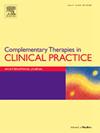Healthcare professionals’ attitudes to animal assisted activity with dogs in paediatric care
IF 2.2
3区 医学
Q2 INTEGRATIVE & COMPLEMENTARY MEDICINE
引用次数: 0
Abstract
Background
Hospitalization for children often involves stress induced by fear and pain. Complementary therapies, such as Animal Assisted Activities (AAA) with dogs, can alleviate the hospital experience.
Purpose
The first aim of this study was to initiate the development of an instrument that measures healthcare professionals’ attitudes toward complementary therapy, specifically dogs in AAA. The second aim was to elucidate the emerging effects of introducing dogs to children in healthcare settings, as reported by healthcare professionals.
Materials and methods
A questionnaire covering demographics, rating attitudes, and allergy and hygiene risks, followed by open-ended questions, was completed by 61 healthcare professionals (HCPs). Quantitative data were analysed statistically, while qualitative data underwent content analysis.
Results
The Attitude Instrument of Complementary Therapy (AICT) included 7 items and was evaluated using exploratory factor analysis. Healthcare professionals had a median score of 25 (range 18–28), high scores indicating a more positive attitude. However, 36 % of the HCPs perceived a risk of allergies, and this group had a significantly lower median score, 22 versus 26. Open-ended answers were analysed into four categories: “Dogs could positively affect children in hospital”, “Dogs may pose a risk of allergies in children”, “Dogs might be frightening for children” and “Dogs can affect healthcare professionals’ working situation”.
Conclusion
The AICT can serve as a valuable tool for investigating HCPs’ attitudes to dogs in AAA as complementary therapies. Professionals view dogs as beneficial for hospitalized children, but attitudes toward dogs working in paediatric care can be influenced by concerns about risks such as allergies.
求助全文
约1分钟内获得全文
求助全文
来源期刊

Complementary Therapies in Clinical Practice
INTEGRATIVE & COMPLEMENTARY MEDICINE-
CiteScore
6.30
自引率
6.70%
发文量
157
审稿时长
40 days
期刊介绍:
Complementary Therapies in Clinical Practice is an internationally refereed journal published to meet the broad ranging needs of the healthcare profession in the effective and professional integration of complementary therapies within clinical practice.
Complementary Therapies in Clinical Practice aims to provide rigorous peer reviewed papers addressing research, implementation of complementary therapies (CTs) in the clinical setting, legal and ethical concerns, evaluative accounts of therapy in practice, philosophical analysis of emergent social trends in CTs, excellence in clinical judgement, best practice, problem management, therapy information, policy development and management of change in order to promote safe and efficacious clinical practice.
Complementary Therapies in Clinical Practice welcomes and considers accounts of reflective practice.
 求助内容:
求助内容: 应助结果提醒方式:
应助结果提醒方式:


